

Tomb Raiders Threaten Mayan City's History. Khanacademy. SURVEYING. Khanacademy. Khanacademy. Tlaltecuhtli Plaque · Tlaltecuhtli Plaque · Tenochtitlan. Tlaltecuhtli is the Mexica earth deity associated with the consumption of the dead and the fertility of the earth.
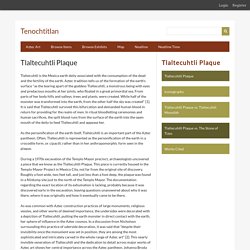
Aztec tradition tells us of the formation of the earth's surface "as the tearing apart of the goddess Tlaltecuhtli, a monstrous being with eyes and predacious mouths at her joints, who floated in a great primordial sea. From parts of her body hills and valleys, trees and plants, were created. Tlaltecuhtli Colossal Monolith was Moved to Templo Mayor Museum. MEXICO CITY.- The Tlaltecuhtli monolith discovered near Templo Mayor Archaeological Site in 2006 was moved in May 17th 2010 to Templo Mayor Museum, where it is to be presented for the first time as part of the Moctezuma II, Time and Destiny of a Ruler exhibition.
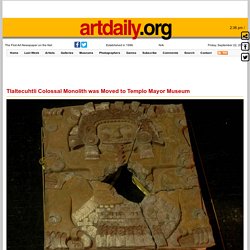
The colossal sculpture was relocated in a maneuver that used state-of-the-art technology and the work of several persons during more than 31 hours. It was moved from the Ajaracas plot to the museum using 2 cranes to lift the four fragments in which the 12 tons piece was found. Trailers transported it through Justo Serra and Correo Mayor Streets to the building where main doors were previously removed to allow the introduction of the enormous stone. Electron Beam Points to Origins of Teotihuacan Stone Faces. NOVA - Official Website. Share By Peter Tyson Posted 02.13.01 NOVA In its heyday from about A.D. 300 to 900, the Maya civilization boasted hundreds of cities across a vast swath of Central America.

Now archeological sites, these once-flourishing cities extended from Chichén Itzí¡ in the northern Yucatí¡n to Copí¡n, about 400 miles to the south in modern-day Honduras. Each bore ceremonial centers where theocratic rulers practiced a complex religion based on a host of gods, a unique calendar, and ceremonies that featured a ball game and human sacrifice. NOVA - Official Website. Cracking the Maya Code PBS Airdate: April 8, 2008 NARRATOR: Imagine explorers arriving to find our cities deserted; our books have perished in some unknown catastrophe; all that is left to speak for us are the written words we have carved in stone.
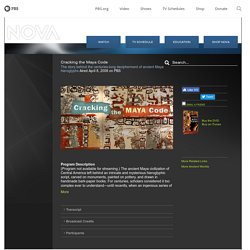
The travelers cannot make sense of our mysterious script, but if they could, would they comprehend who we were? Confirmed: Mysterious ancient Maya book, Grolier Codex, is genuine. Non-invasive geophysical techniques help archaeologists study Pakal II's crypt. MEXICO CITY.- Anomalies that correspond to a pair of 2 and 3 meter [6.56 and 9.84 feet] cavities detected by a georadar in the front part of the Temple of Inscriptions in Palenque, and the corroboration that the Pakal II crypt doesn’t rest over original rock, signal that this funerary chamber was not the starting point of this celebrated Mayan construction, as it’s discoverer (archaeologist Alberto Ruz Lhuillier) suggested.
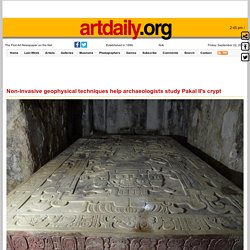
In new study, Mexican researchers extract intact DNA from Palenque's Red Queen. Palenque (Classic Period) – Smarthistory. Google photosphere of Palenque: view of the Temple of Inscriptions from the Palace King Pakal and the expansion of Palenque According to Maya glyphic inscriptions, the city of Palenque (in what is today southern Mexico)—comprised of temples, a ballcourt, and the largest surviving Maya palatial complex—was established in 432 C.E.
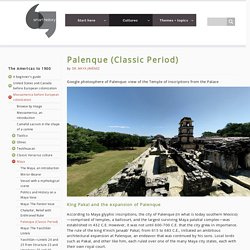
However, it was not until 600-700 C.E. that the city grew in importance. The rule of the king K’inich Janaab’ Pakal, from 615 to 683 C.E., initiated an ambitious architectural expansion at Palenque, an endeavor that was continued by his sons. Local lords such as Pakal, and other like him, each ruled over one of the many Maya city states, each with their own royal court. In Search of the Lost Empire of the Maya. By Erik Vance Photographs by David Coventry This story appears in the September 2016 issue of National Geographic magazine.
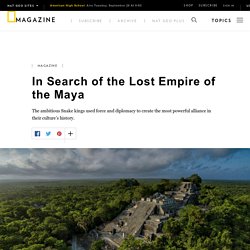
Your National Geographic Society membership helped fund recent excavations at Holmul and La Corona, Guatemala. The ancient city of Holmul isn’t much to look at. Visual Time Machines. Group in Great Plaza: George Byron Gordon is seated wearing boots, Ismael Vallecido of Guatemala is left, George Shorkley stands to the right with arms folded, and Edmund Lincoln is in front of him.

Photo by Felipe Deisderios, 1893. PM 2004.24.520 This group photo records one of the first official visits from local departmental government authorities to the expedition, Hugh W. Price (left), mayor (on horse, center) and Don Teodoro Destephan, (left), photo by Marshall Saville, 1892. PM 2004.24.14. Pre-Hispanic City of Teotihuacan. Tomb Raiders Threaten Mayan City's History. Cooling U.S. Market Sends Tomb Raiders Abroad.
Ancient carving stolen decades ago in Mexico found in France. A nearly 3,000-year-old carving stolen more than four decades ago from a remote area of southern Mexico has been recovered in France.

The Olmec carving dating to around 900 B.C. had been chipped off the rock face sometime between the arrival of an archaeological team in 1968 and 1972, when the team returned to the area. It resurfaced recently in France under unclear circumstances. Foundation for the Advancement of Mesoamerican Studies, Inc. Unframed The LACMA Blog. Today, a few behind-the-scenes photos from the installation of Olmec: Colossal Masterworks of Ancient Mexico—one of the Resnick Pavilion’s inaugural exhibitions opening October 2.

Hand painted onto the exhibition’s walls, this portion of a mural portrays a Maya dignitary carrying an Olmec-style baby, who represents the infant maize god. A royal figure dressed in an elaborate bird mask and ornaments form another mural. The zoomorphic throne may allude to ceremonies that occurred when the figure acceded to office. Curator Virginia Fields examines a rare collection of objects that were recovered from a sacred site in the Olmec heartland. NOVA - Official Website. Ancient Mayan Mural Found in Guatemala. A Maya Masterpiece Revealed. Share By Peter Tyson Posted 01.09.07 NOVA In March 2001, archeologist Bill Saturno, eager to find shade and rest after a grueling trek through northern Guatemala in search of Maya hieroglyphics, crawled down a looter's trench into the base of an ancient, jungle-covered Maya structure.
Finding himself in darkness, he casually switched on his flashlight—and that is when he discovered a masterpiece of early Maya art, which includes some of the earliest and most enigmatic Maya glyphs yet found. The colorful mural graces a long-buried room predating the time of Christ, one of many structures in a site now known as San Bartolo. In this interactive, explore the mural room's 14-foot-wide North Wall through archeological illustrator Heather Hurst's stunning color rendering.
Launch Interactive. Oldest Known Maya Mural, Tomb Reveal Story of Ancient King. December 13, 2005. Oldest Known Maya Mural, Tomb Reveal Story of Ancient King. Dawn of Maya Gods and Kings. The two artists worked by torchlight and morning sunshine. Perhaps they were twins, like the twin artist-scribes of Maya myth, although their styles were distinct. Certainly they had trained for their task since youth, copying images and text from the accordion-fold books that held the sacred stories.
Now, under their brushstrokes, the gods and their acts of creation burst to life on polished plaster. Dawn of Maya Gods and Kings. Lost King of the Maya. Tour Copán with David Stuart. Tour Copán with David Stuart. Nahuatl Dictionary/Diccionario del náhuatl. Khanacademy.